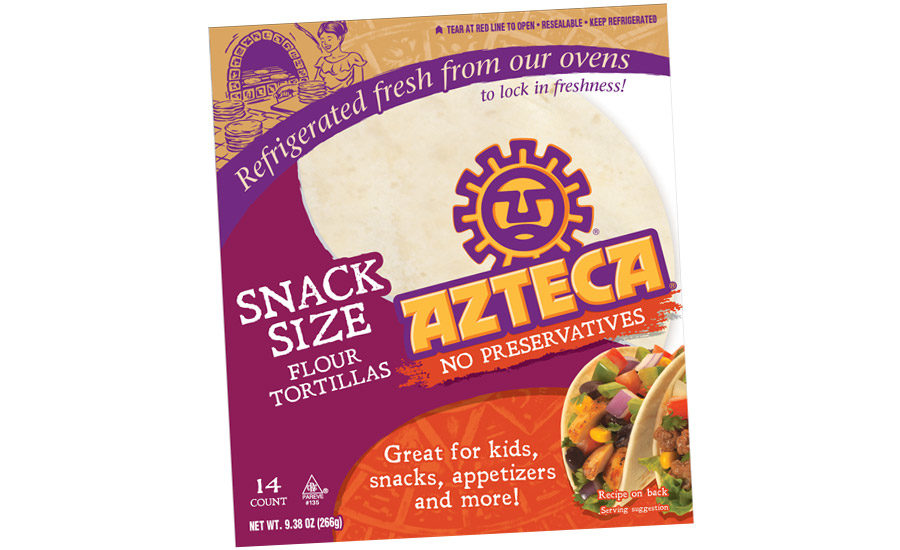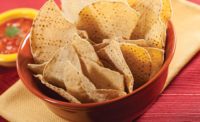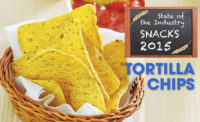Americans are continuing to explore international cuisines. Indian, Mediterranean, Thai, Vietnamese and other ethnic restaurants are now fixtures in major cities and their surrounding suburbs. Even small towns typically have at least one Mexican restaurant nowadays. According to CHD Expert, Chicago, there were more than 54,000 Mexican restaurants in operation in the U.S. as of May 2014, representing 8 percent of the total national restaurant landscape.
As they discover flavorful new dishes at these ethnic eateries, Americans are becoming more acquainted with the flatbreads on the menus—bánh trang, lavash, pita, roti, naan and, of course, tortilla.
And tortillas still unquestionably sit atop of the flatbread heap. For the 52 weeks ending Feb. 22, 2015, per IRI, Chicago, sales of hard/soft tortillas and taco kits hit $2.25 billion, up 5.02 in dollar sales. Elsewhere across the store, IRI reports that dollar sales for refrigerated tortillas totaled $108.77 million for the period, while dollar sales for frozen tortillas were $2.51 million, up a notable 19.56 percent.
A healthier option
While the popularity of Hispanic foods continues to drive consumer demand for tortillas, so does their versatility. “Tortillas are just not for traditional Hispanic foods anymore,” says Julie Nargang, vice president of marketing/innovation, Azteca Foods Inc., Chicago. “Due to their versatility, they transcend food types and meal dayparts.”
Tortillas also maintain connections to better-for-you. Nargang notes consumer trends these days are not to “diet,” but to take initiatives to “eat healthier,” and people continue to seek out tortillas to support these dietary desires.
Azteca’s entire product line—anchored by its “No Preservatives” refrigerated flour tortillas—offers healthier options, says Nargang. The company’s new Snack Size No Preservatives Flour Tortilla, for instance, contains no preservatives, high-fructose corn syrup, artificial colors or artificial flavors. At 4 inches, it also serves as a carrier for smaller meals, offers portion control and facilitates variety.
While Criss K. Cruz, president and CEO, Mi~Rancho Tortillas Inc., Clovis, CA, acknowledges a growing health trend in the tortilla industry, he says that growth is “very selective and marginally minimum. We haven’t seen it gravitate to the level we thought it would on margins of manufacturing. Traditional customers are still looking for something they can connect with.”
Cruz recalls the introduction of whole-wheat tortillas more than 20 years ago. “They were intended to be one of the biggest new pushes of the time,” he says. “The tortilla industry was convinced that whole wheat would do for tortillas what it did for bread. Today, the whole-wheat market in the tortilla category is still only like 2 percent.”
However, more growth might prove imminent. Alexa LaVere, sales and marketing supervisor, Mi Rancho, San Leandro, CA, notes that her company receives a lot of requests for whole-wheat tortillas. “The whole-wheat requests are growing, especially within schools, due to dietary requirements for whole grains,” she says.
Organic and gluten-free
For many consumers, eating “healthy” not only means buying products that offer comparative per-serving improvements on fat, calories and other nutritional aspects, it means products made without preservatives or artificial ingredients, and featuring “natural” and organic ingredients.
“One of the largest trends driving the tortilla market is the growth of the organic and natural foods industry,” says LaVere. “Especially with corn tortillas, consumers are ardently searching for certified-organic and non-GMO corn tortillas.” She says her company’s Organic Corn Tortillas are the company’s best-sellers.
The company also recently launched a new line of certified-organic and “made with organic (specified ingredients)” products for foodservice. “These are growing in popularity, as restaurants and grocers seek to support the demand of healthier meal choices,” says LaVere, adding that an organic consumer line will soon hit stores.
Mi Rancho is also conducting research with other grains, such as sorghum and millet. “We may be able to use them to develop gluten-free tortillas with high nutritional benefits,” LaVere says. “These items are still in development, but they continue to be a high priority as we look forward to bringing delicious items to the market.”
Rudi’s Organic Bakery also is continuing to see demand for organic tortillas with simple ingredient lists, according to Lauren Beno, associate brand manager, Rudi’s Bakery, Boulder, CO. “We make sure that, regardless of whether Mom chooses our 7 Grain with Flax Wraps, Multigrain Wraps, Spelt Tortillas or Whole Spelt Tortillas, she can feel good knowing she’s feeding her family a tortilla or wrap with only the best ingredients,” she explains.
Rudi’s Gluten-Free Bakery, also part of Rudi’s Bakery, continues to see demand for gluten-free tortillas. “Our gluten-free tortillas taste and feel just like the real thing, which makes them a great option for the entire family,” says Beno. “They’re soft, pliable, have 5 grams of fiber per serving and are made with a simple ingredient list.”
Rudi’s Organic Bakery and Rudi’s Gluten-Free Bakery tortillas and wraps are also free of soy, dairy, egg and GMOs.
Flat and flavorful
While Paqui Tortillas, Austin, TX, sees the demand for gluten-free tortillas and has been watching the market for some time, it works carefully not to follow trends, says Doug Lyons, chief happiness officer of the company. He notes that the company prefers to focus on “handcrafted” quality.
The company produces four unique flour tortilla varieties using no artificial flavors or ingredients: Buttermilk, Roasted Jalapeño, Cilantro, and Pumpkin & Spice. “We make all of our purées in-house, which includes juicing fresh cilantro and roasting our own jalapeños, so all Paqui tortillas are located in the refrigerated section” explains Lyons. “We make our tortillas fresh to order each week, and they are in stores within 24–48 hours of being made.”
While Paqui currently only produces flour tortillas for the retail market, Lyons says the company is developing a corn tortilla.
The Mi Familia Butter Flavored 8-inch Flour Tortillas product is Mi~Rancho’s signature item, says Cruz, explaining that the company’s Mi Familia brand, developed by his son about two years ago, is available in Northern and Southern California. Its Mi Rancho brand can be found throughout central California.
Cruz cites his heritage as the inspiration for the butter-flavored product. “That’s what I grew up with,” he says. “My grandmother from my Mexican culture would make flour tortillas with butter. My mom’s side of the family is from the East Indian culture, so my other grandmother would make whole-wheat tortillas with butter.”
Distinctive tortilla chips
Tortilla chips enhance snack times by serving as sturdy—and often better-for-you—bases for salsas, dips, hummus and other toppings. And consumers are biting, driving dollar sales for the tortilla/tostada chips category up 3.83 percent for the 52 weeks ending Feb. 22, 2015, to $4.71 billion in sales, per IRI.
Several consumer trends impacting the tortilla category are also apparent in tortilla chips. For instance, continued demand for gluten-free products is prompting more snack manufacturers to introduce or expand existing gluten-free lines—a feat that isn’t too much of a stretch for the largely corn-based chips.
“Gluten-free is something that we’ve just seen continuing to gain momentum,” says Sam Garfinkel, senior brand manager, snacks, Garden of Eatin’, a brand of the Hain Celestial Group, Lake Success, NY. “Where appropriate and where we’re able to, we look to make our products gluten-free.”
Garden of Eatin’ is known for its Blue Corn Tortilla Chips. “We’re kind of a leader in that emerging corn segment,” says Garfinkel, adding that the company also offers white, yellow and red corn tortilla chips. Its Blue Chips were up 47.2 percent in dollar sales to $29.24 million over the past year, per IRI.
Snak King Corp., City of Industry, CA, recently launched a gluten-free, rolled tortilla chip called CrunchStix Multigrain Dippers under its The Whole Earth brand. Joe Papiri, vice president of sales and marketing for the company, notes that the snack is made from seven grains and seeds, consisting of about 50 percent rice. He adds that it makes a great dip chip for hummus and other creamy dips.
Papiri notes that Snak King is also still seeing growth for organic tortilla chips, notably its Organic Blue Tortilla Chips.
Distinctions abound in tortilla chips today. Garden of Eatin’ makes all its tortilla chips with organic corn and non-GMO ingredients. “The focus on our ingredients is what separates us,” says Garfinkel. “Most of our items are verified as non-GMO by the Non-GMO Project. I think that’s where the equity of the brand really lies—in sourcing ingredients that consumers can feel good about.”
Tortilla chips’ next wave
While corn is still the go-to ingredient for tortilla chips, new products made with diverse ingredients are addressing consumer demand for healthier snacks, often delivering unconventional flavors and textures.
According to Garfinkel, Garden of Eatin’ has focused on several different formulation tactics. “We had a few line extensions that featured some very on-trend ingredients—kale being one of them, and chia seed being another,” he says. “We took our corn tortilla chips and integrated some of these on-trend ingredients into the corn tortilla base. It provides for some interesting flavor profiles.” He believes we’ll start to see more companies integrate emerging ingredients and flavor profiles into an approachable format—like tortilla chips—that more mainstream consumers might be able to pick up on. “I think that’s exactly what you’ll see with our kale and chia seed tortilla chips for Garden of Eatin.’”
The market can also expect to see more natural, restaurant-style tortilla chips in the future. “They’re thin, they’re crispy and they’re flaky—kind of like what you’d get at a more-authentic Mexican restaurant,” Garfinkel explains. Garden of Eatin’ recently introduced two such products: Cantina Style Blue Corn Tortilla Chips with Sea Salt and Cantina Style White Corn Tortilla Chips with Lime.
They join a number of restaurant-style tortilla chips already on retailers’ shelves, including Garden Of Eatin’ Restaurant Style White Corn Tortilla Chips, Late July Restaurant Style Tortilla Chips, Mission Restaurant Style Tortilla Triangles, Tostitos Cantina Style Thin & Crispy and Tostitos Original Restaurant Style Tortilla Chips.
Even though straightforward tortillas and tortilla chips still account for the lion’s share of category revenue, such mainstay products are beginning to see more competition. As more consumers expand into diversified offerings, the net effect is of tortillas and tortilla chips gaining more share of stomach. People want tortillas and tortilla chips made with wholesome ingredients, with versatile and nutritious qualities that address dietary needs and desires, and the market is ready to deliver.













